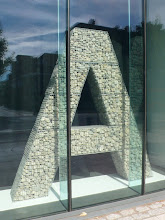At my confirmation/upgrade meeting it was pointed out that the proposed title of my PhD contained at least 3 words with potentially contentious or unclear definitions—landscape, the everyday and geo/graphic. I have been using geo/graphic for a few years now, probably since 2005, and it has gone down well, particularly in Geography circles. So well, perhaps I should ™ it! However, as yet, I have not specifically defined it or explored how and why I am using the / character. So here is a bit of a stab at this...
A literal translation of the word geography is earthwritings, coming from geo—earth and graphy—writing. By taking the word geographic and inserting the / between the two elements of the whole word I wanted to re-emphasise its constituent parts—geo and graphic. Graphic these days is perhaps associated more with pictures than with words and, as a graphic designer, graphic also obviously relates to my home territory. This hopefully shifts the interplay of meaning to a more visual end and points towards the cross disciplinary nature of the study. It is this visual side of things that geographer's seem uncomfortable with—as Chris Perkins says, geographers don't make things anymore; they are very good at deconstruction, but not so good at construction. Incidentally, this sentence was probably the starting point for my PhD.
This is quite a literal description of the use of the / so far, but taking it further, I remember reading an article a while ago called A/r/tography as living inquiry, by Springgay, Irwin and Wilson Kind. The article is about the potential for using 'arts-based' research within an educational research context and it is a bit 'out there' in my view, but it did contain the following that is interesting in relation to my idea of geo/graphic and the use of the /.
The slash is particular in its use, as it is intended to divide and double a word—to make the word mean at least two things, but often more. It also refers to what might appear between two points of orientation, hinting at meaning that is not quite there or yet unsaid. This play between meanings does not suggest a limitless positionality, where interpretation is open to any whim or chance. It is the tension provoked by this doubling, between limit/less that maintains meaning's possibility. The slash is not intended to be one or the other term; it can be both simultaneously, or neither. The slash suggests movements or shifts between the terms. For example, the term un/familiar is a movement between the familiar and the strange. The slash makes the terms active, relational, as they reverberate with, in, and through each other
(Springgay, S, Irwin, R & Wilson Kind, S, 2005: 904)
This research is cross-disciplinary, and in talking about interdisciplinarity, Phelan and Rogoff (2001) describe it as a place of being 'without'. That one leaves behind the certitudes of previous work and processes without yet having found a new methodology to replace them. So perhaps the use of / also highlights this gap as a productive new place to be found between the discplines of geography and graphic design?
The / could also be seen as a kind of fold, with graphics and geography folding into each other, around each other, etc. Springgay et al quote Meskimmon (2003) in relation to folding:
Folding holds out the potential to diversify endlessly without falling into the logic of binary oppositions. This sense of the fold thinks matter as doubling back upon itself to make endless new points of connection between diverse elements.
This idea of a productive interplay between the two elements also makes me think of the idea of montage and the 'charge' that can be created by the coupling of two diverse elements or images.
So, it would seem there are a multitude of powers hidden within the humble /.
Does the - offer the same potential? Whilst contemplating the problems around representation, I had moved to thinking of a re-presentation, rather than a representation. This perhaps shifts the reader into active mode—they are not passively accepting a representation of something. Or maybe it makes the author/designer more active. The difference between a drawing and an illustration for example... But, would it be more productively stated as re/presentation?
I guess with a - I was trying to imply that the artefact in question was a new or different presentation, not a stab at creating some kind of visually replicable 'truth'. However, taking the previous thinking about the / on board, the - perhaps is a little one dimensional in its effect. It literally makes a simple, direct connection between the two things. The angle of the / allows for more changes of direction, each word seems to move both towards and away from the other—a more interactive coupling, with the / acting as a kind of fulcrum. So with re/presentation perhaps it brings into play the obvious idea about a new presentation, but perhaps also alludes to the question of the word representation in a more dynamic way. It also could be seen to be highlighting the question of presentation itself by reading the re as in 'about'.
I guess this kind of discussion can get lost in itself, or perhaps up itself, but I think it is kind of interesting to think about the potentially powerful semantic changes or possibilities that can be gained by the use of a humble /!


No comments:
Post a Comment